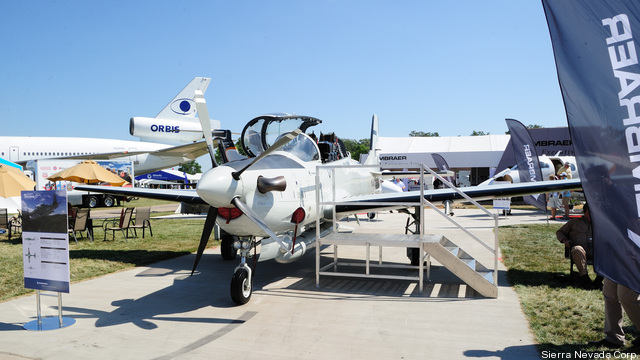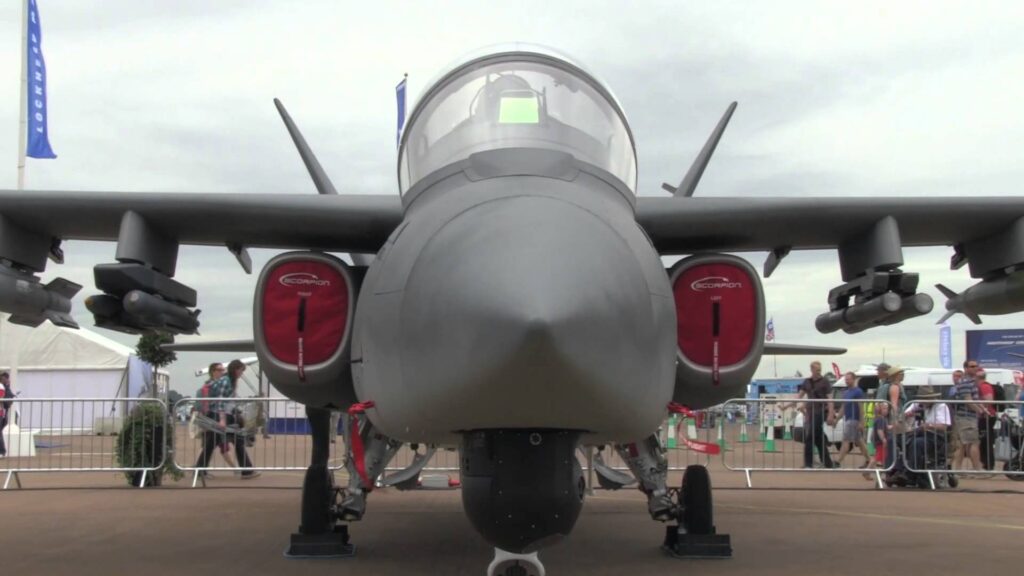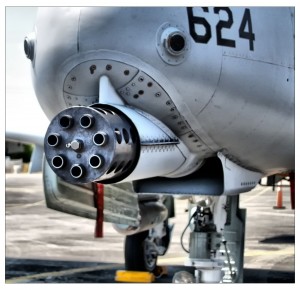
Embraer Super Tucano ground attack aircraft
UPDATED: Adds Ayotte Comment
WASHINGTON: The Air Force is considering not one, but two replacements for the aging A-10 Warthog close air support plane. But analysts wonder why, given that the service is already building a new bomber (the B-21), a new tanker (the KC-46), a new fighter (the F-35A), they would want to build two Close Air Support aircraft in an era when trillion dollar deficits are once again on the horizon?
The news, broken by my colleague Lara Seligman at Aviation Week, comes from what appears to be an increasingly common tactic at the Pentagon, where think tank types get briefed on news before the news media. And then it leaks, as, one assumes, the Pentagon intends.

Textron AirLand Scorpion
In this case, Lt. Gen. Mike Holmes, the Air Force’s deputy chief of staff for strategic plans and requirements, told a gaggle of think tank types last Wednesday that the service is considering buying two Close Air Support aircraft:
The OA-X would be a buy of 250 prop-driven aircraft for “permissive” environments. The two planes that appear to be in contention are the Embraer A-29 Super-Tucano and the Textron Beechcraft AT-6 since they meet the criteria of being off-the-shelf aircraft, which Holmes stressed as a requirement for this plane. Textron’s intriguing Scorpion, which has been touted as a possible CAS aircraft, is non-developmental so it wouldn’t be considered for the OA-X.
But the other aircraft, the A-X2, would be designed to fly in the face of higher-tech opposition in the form of surface-to-air missiles and other opposition, but not the high-end threats known as Anti-Access/Area Denial systems. (A2/AD would be the purview of the F-35 and other fifth-generation aircraft). The Scorpion could be considered for this. The Marines, who are writing the Close Air Support doctrine for the F-35, have praised its CAS performance so far. That said, the plane won’t have its most advanced weapons for CAS, such as the Small Diameter Bomb II, until the Block 4 software.
Still, the question arises: since the F-35A is intended to replace the A-10 for Close Air Support, why does the Air Force need another CAS asset?
The answer appears to be that the less advanced aircraft would have longer loiter times, allowing them to provide more persistent CAS. And they help the Air Force lower its flight hour costs, allowing them to boast higher readiness rates over time for much less money, according to Mark Gunzinger, one of the think tank analysts who was briefed by Gen. Holmes.

The A-10’s business end
Gunzinger, an analyst with the respected Center for Strategic and Budgetary Assessment, said “my personal opinion is the Air Force ought to try and fly the wings off the A-10,” because we’ve got it now and it provides such superb service. His view may also reflect the skepticism of many Air Force watchers about the costs of A-10 flight hours cited by the service.
Buying these other CAS aircraft would provide the Air Force, already fielding the smallest and oldest air fleet in its history, with more cockpits to provide pilots with flying hours and the ability to hone their skills, Gunzinger and defense consultant Loren Thompson say.
UPDATE ADDS AYOTTE COMMENT Sen. Kelly Ayotte, a fervent supporter of the A-10, issued a statement saying she would not support retirement of the A-10 until” a replacement reaches full operational capability” and pretty much works as well as the A-10. She is locked in a very tight race for her seat in New Hampshire, though the Cook Report notes “that private polling shows Ayotte with a small but steady lead” over Democratic Gov. Maggie Hassan. Should Ayotte win we can be sure she would lean in to some effect on this issue.
No money has yet been placed in the Program Objective Memorandum (POM), which is largely shaped already — though major decisions may well be made into the new year, depending on how the presidential elections turn out.
In the meantime, the Air Force clearly is floating these ideas to see how they, um, fly.
Navy jet trainer fleet operations remain paused after engine mishap
One week after the incident, a Navy spokesperson says the service is continuing to assess the fleet’s ability to safely resume flight.


























